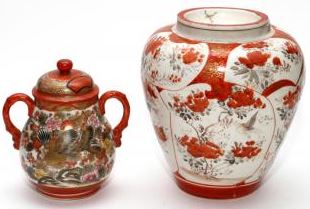Identification and Price guides for Antiques & Collectibles


ANTIQUE AND COLLECTIBLE KUTANI JAPANESE PORCELAIN:
A Rich History and Timeless Beauty
Join the most updated and complete collectibles research online - Learn more...
 Kutani porcelain is a type of Japanese porcelain that originated in the Kutani village in the Ishikawa Prefecture of Japan during the Edo period (1603-1868). Kutani porcelain is known for its rich history and timeless beauty, making it a popular choice for antique collectors and enthusiasts around the world. In this article, we'll take a closer look at the history and characteristics of Kutani porcelain, as well as tips for collecting and caring for these beautiful pieces.
Kutani porcelain is a type of Japanese porcelain that originated in the Kutani village in the Ishikawa Prefecture of Japan during the Edo period (1603-1868). Kutani porcelain is known for its rich history and timeless beauty, making it a popular choice for antique collectors and enthusiasts around the world. In this article, we'll take a closer look at the history and characteristics of Kutani porcelain, as well as tips for collecting and caring for these beautiful pieces.
The History of Kutani Porcelain
The history of Kutani porcelain can be traced back to the 17th century when a kiln was established in the Kutani village in Ishikawa Prefecture. The kiln produced a distinctive style of porcelain that was characterized by bold designs, vibrant colors, and intricate detailing. Kutani porcelain quickly gained popularity in Japan and was even exported to other countries.
During the Meiji period (1868-1912), the production of Kutani porcelain declined due to competition from other porcelain manufacturers and changing consumer tastes. However, in the 1950s, a group of Kutani craftsmen revived the art of Kutani porcelain, and the industry has been thriving ever since.
The Characteristics of Kutani Porcelain
Kutani porcelain is known for its distinctive style and characteristics. Some of the key features of Kutani porcelain include:
- Bold designs: Kutani porcelain is characterized by bold designs that feature a combination of colors, patterns, and images. The designs often feature landscapes, people, animals, and nature scenes.
- Vibrant colors: Kutani porcelain is known for its vibrant colors, which are achieved through the use of a unique color palette that includes red, blue, yellow, green, and purple. The colors are applied using a technique called overglaze, which involves applying the color on top of a glaze that has already been fired.
- Intricate detailing: Kutani porcelain is renowned for its intricate detailing, which is achieved through a combination of painting, carving, and gilding techniques. The detailing often features gold and silver accents, which add to the beauty and elegance of the piece.
Collecting Kutani Porcelain
Collecting Kutani porcelain can be a rewarding and fulfilling experience for antique enthusiasts. However, it's important to have a basic understanding of the market and the value of the pieces before making a purchase. Here are some tips for collecting Kutani porcelain:
- Research the market: Before making a purchase, it's important to research the market and familiarize yourself with the types of pieces that are available, their value, and the current trends in the market. This will help you make an informed decision and avoid overpaying for a piece.
- Inspect the piece: When inspecting a piece of Kutani porcelain, it's important to look for signs of damage, such as cracks, chips, or repairs. These can significantly reduce the value of the piece. It's also important to look for signs of authenticity, such as the maker's mark or signature.
- Buy from reputable dealers: To ensure that you're getting a genuine piece of Kutani porcelain, it's important to buy from reputable dealers who have a good reputation and are knowledgeable about the market. This will give you peace of mind and ensure that you're getting a fair price for the piece.
Caring for Kutani Porcelain
Kutani porcelain is a delicate and fragile material, and it's important to take proper care of it to ensure that it remains in good condition. Here are some tips for caring for Kutani porcelain:
- Handle with care: When handling Kutani porcelain, it's important to be gentle and careful. Avoid placing too much pressure on the piece and always hold it with both hands to distribute the weight evenly.
- Keep it clean: To keep Kutani porcelain clean, it's important to dust it regularly with a soft, dry cloth. Avoid using water or cleaning solutions, as these can damage the porcelain.
- Store carefully: When storing Kutani porcelain, it's important to wrap it in acid-free tissue paper or bubble wrap to protect it from scratches and other damage. Store it in a dry, cool place away from direct sunlight and extreme temperatures.
Conclusion
Kutani porcelain is a beautiful and timeless material that has captured the hearts of antique collectors and enthusiasts around the world. Its rich history, bold designs, vibrant colors, and intricate detailing make it a unique and valuable addition to any collection. By following the tips for collecting and caring for Kutani porcelain outlined in this article, you can ensure that your pieces remain in good condition and continue to bring joy and beauty for years to come.
Unlock the true value of your collection with our comprehensive research guides from identifying makers' marks to appraising all kinds of antiques and collectibles, including items featured in this article.
Our up-to-date information will give you an accurate understanding of your items' worth. Don't miss out on this valuable resource - visit our research tools today!
In addition to some examples shown below on this page, you can also search our price guide for your own treasures.
Examples of related items from our Price Guides
-
TWO SIMILAR KUTANI GOURD VASESProperty from [more like this]
-
Box Japanese Kutani Cat etc. [more like this]
-
Old Japanese Large Kutani Porcelain Pitcher [more like this]
-
Japanese Large Kutani Standing Guanyin Figure [more like this]
-
PAIR OF JAPANESE KUTANI PORCELAIN MANEKI [more like this]
-
A LARGE WATANO JAPANESE KUTANI VASE WITH [more like this]
-
A SELECTION OF ASIAN ARTWORKS Includes four [more like this]
-
THREE JAPANESE KUTANI BOWLS Edo period (1615-1868), [more like this]
-
JAPANESE HAND-PAINTED KUTANI WARE BOWL 3"H [more like this]
-
ASSORTED JAPANESE ART POTTERY & OTHER DECORATIONS [more like this]
-
ASSORTMENT OF JAPANESE PORCELAIN & WOOD CARVINGS [more like this]
-
JAPANESE KUTANI PORCELAIN FOOTED COMPOTE [more like this]
There are many more auction results available to our members...
Explore more items from our
Antiques & Collectibles Price Guide
JAPANESE KUTANI PORCELAIN FOOTED COMPOTE[more like this]
GROUP OF PORCELAIN, TO INCLUDE A SET[more like this]
3pc Japanese Kutani Porcelain Covered[more like this]
ASSORTED GROUP 6 PIECES OF PORCELAINAssorted[more like this]
(56) JAPANESE SUZUKI COMPANY DINNER[more like this]
FOUR PIECES OF JAPANESE PORCELAIN LATE[more like this]
JAPANESE CELADON PORCELAIN FOOTED COMPOTE[more like this]
SELECTION OF DRESDEN STYLE PORCELAIN[more like this]
JAPANESE PORCELAIN BLUE AND WHITE DECORATED[more like this]
FRENCH MONOGRAMED PORCELAIN TUREEN AND[more like this]
2 SATSUMA JAPANESE PORCELAIN BOWLS2[more like this]
This list is limited to only a few results.
Many more items are available to our members through our
Price Guides!






